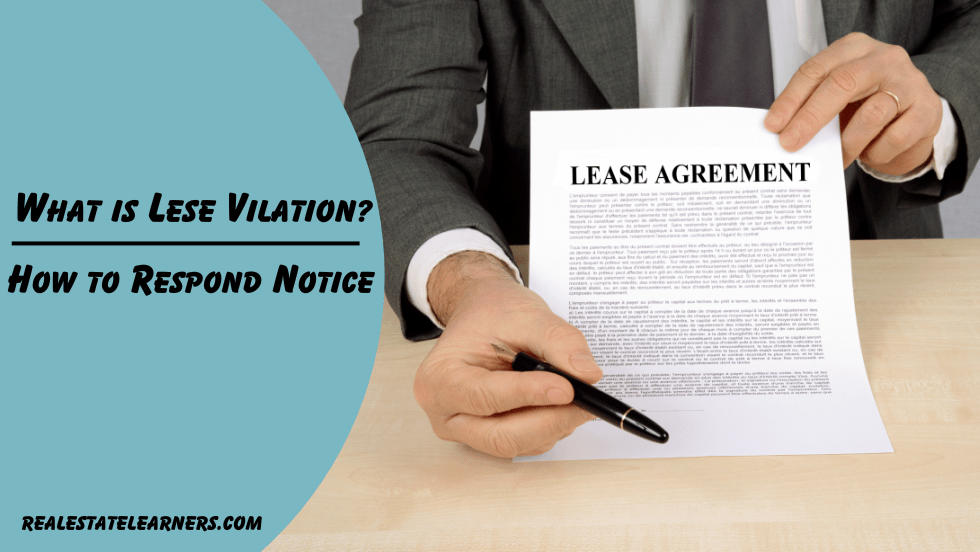When renting or leasing a property, the tenant and landlord enter into a legally binding agreement known as a lease. This document outlines the terms and conditions of the rental arrangement, including but not limited to rent amount, duration of lease, and any rules or regulations that must be followed.
Unfortunately, sometimes, the tenant does not follow these rules and regulations, resulting in a violation of the lease agreement. In such cases, the landlord can take legal action against the tenant for breaching the contract. In this document, I would like to discuss what a lease violation means in the real estate industry and what steps can be taken by both parties involved in such a situation.
What is a lease violation?
A lease violation occurs when a tenant fails to adhere to the terms and conditions outlined in their rental agreement. This can include not paying rent on time, having unauthorized pets or guests, causing damage, or using the property for illegal activities.
Lease violations are considered serious offenses and can result in consequences such as eviction, fines, or legal action.
What is the Example of Lease Violation in Real Estate?
One common example of a lease violation in real estate is when a tenant subleases their apartment without permission from the landlord. Subleasing is when a tenant rents out their apartment to another person, usually for a shorter period and at a higher price. This is against the terms of most lease agreements, as it puts the landlord at risk of having an unknown individual living in their property.
Another example of lease violation in real estate is unauthorized pets. Most lease agreements specify whether or not pets are allowed on the property, and if they are, what type of pets are permitted. If a tenant brings in a pet without prior approval from the landlord, it is considered a violation of their lease agreement. This can pose potential risks to both the property and other tenants.
What Is a Lease Violation Real Estate?
A lease violation in real estate occurs when a tenant fails to comply with the terms and conditions of their lease agreement. This can happen for various reasons, such as non-payment of rent, damaging the property, or violating any other rule stated in the lease.
Lease violations are taken very seriously by landlords and property managers, as they disrupt the landlord-tenant relationship and can result in legal consequences for both parties involved.
Does a lease violation go on your record?
A lease violation can go on your record and hurt your rental history. This can make it difficult to secure future rental properties, as landlords often conduct background checks on potential tenants.
Sometimes, a landlord may also report the violation to credit agencies, which can lower your credit score and make it harder for you to obtain loans or other forms of credit.
How Long Does a Broken Lease Stay on Your Record?
The length of time a lease violation stays on your record can vary depending on the severity of the violation and local laws. In most cases, a broken lease or eviction may stay on your rental history for up to seven years.
This means that even after you have fulfilled your lease agreement or resolved the issue with your landlord, the violation may still appear on future background checks conducted by potential landlords.
Types of Lease Violations:
There are different types of lease violations that tenants can commit. Some common examples include:
Non-Payment of Rent: This is the most common type of lease violation where the tenant fails to pay their rent on time or does not pay the full amount due.
Damage to Property: Tenants are responsible for maintaining the property in good condition; any damage caused by them is considered a violation of the lease agreement.
Unauthorized Subletting: If a tenant sublets their apartment without prior approval from the landlord, it is considered a breach of their lease.
Noise Complaints: Most lease agreements have rules regarding excessive noise levels, and if a tenant violates these rules, it can lead to a lease violation.
Unauthorized Pets: If a tenant brings in a pet without informing the landlord or goes against any pet-related rules in the lease agreement, it is considered a violation.
Consequences of Lease Violations
The consequences of lease violations may vary depending on the severity and frequency of the violation and the terms and conditions stated in the lease agreement. Some common consequences may include:
Eviction: In severe cases where the violation threatens other tenants or causes significant damage to the property, the landlord may choose to evict the tenant.
Monetary Penalties: Landlords may charge a late fee for non-payment of rent or any other violation that results in additional costs for the landlord.
Legal Action: If a lease violation is not resolved through other means, landlords may take legal action to enforce the terms of the lease agreement.
Preventing Lease Violations: To avoid lease violations and maintain a good tenant-landlord relationship, it is essential for both parties to clearly understand and communicate the terms and conditions of the lease agreement. Some steps that can be taken to prevent lease violations include:
Conduct thorough tenant screenings before signing a lease to ensure responsible and reliable tenants.
Clearly state all rules and regulations in the lease agreement, including consequences of violating them.
Communicate regularly with tenants and address any issues or concerns promptly.
Encourage open communication and provide a way for tenants to report any issues or violations.
How to respond to lease violation notice?
If you have received a notice of lease violation from your landlord, it is important to address the issue as soon as possible promptly. Here are some steps you can follow when responding to a lease violation notice:
- Understand the violation: Carefully read the notice and ensure you understand what specific rule or term of your lease agreement has been violated.
- Gather evidence: If you believe the violation is unjustified or there is a misunderstanding, gather any evidence or documentation that supports your case.
- Communicate with your landlord: Reach out to your landlord and discuss the situation calmly and respectfully. Explain your side of the story and try to come to a resolution.
- Take corrective action: If you are at fault for the violation, take immediate action to correct the issue and prevent it from happening again.
- Seek legal advice: If you are unsure about your rights and responsibilities as a tenant or if the landlord needs to address the issue appropriately, consider seeking legal advice.
By understanding lease violations and taking proactive measures to prevent them, landlords and tenants can maintain a positive and productive rental experience. It is important always to follow the terms of the lease agreement and communicate effectively to avoid any potential conflicts or legal consequences.
So, both parties must have a clear understanding of their rights and responsibilities in order to maintain a healthy landlord-tenant relationship.
In addition, tenants should also report any supervision or repair issues to the landlord promptly, as failing to do so could also be considered a violation of the lease agreement.
Conclusion:
Lease violations are common in the real estate industry, and landlords and tenants need to beaware of their rights and responsibilities. Understanding the consequences of lease violations and taking preventive measures can help maintain a positive rental experience for all parties involved.

Corey has over 15 years of experience as a real estate broker and educator. He is dedicated to providing valuable insights and guidance for those looking to enter the real estate industry.

